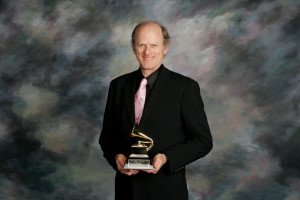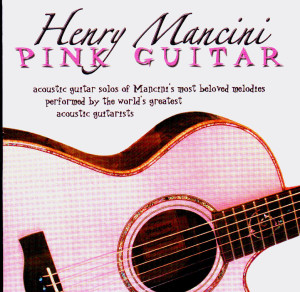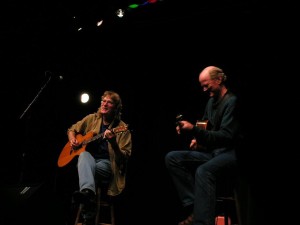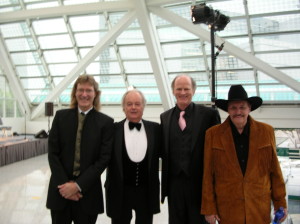Portland, Oregon, acoustic guitarists Mark Hanson and Doug Smith and ten other great players won a Grammy in February, 2005, in the Pop Instrumental Album category for their contributions to the Henry Mancini Pink Guitar CD. This is Mark’s firsthand account of the experience.
To win a Grammy is a lifetime goal of everyone in the recording industry. For some of us older winners it is a validation of a lifetime of work. For some of the younger winners it is the excitement of striking a rich cultural vein at the right time. For all of us it is one of lifetime’s great thrills.
About the Project
The Concept of “Pink Guitar”
Our trip to the Grammys began in the spring of 2004 with an idea for an instrumental album of Henry Mancini tunes arranged for solo fingerstyle guitar. An e-mail arrived from Solid Air Records owner James Jensen in Southern California. Would I be interested in contributing to such a Mancini tribute album? I replied “absolutely” without hesitation.
Solid Air Records is a record label exclusively of acoustic fingerstyle guitarists. Doug Smith’s and my duo album “Power of Two” is on the label, as are my solo efforts Love Songs for Guitar, and Great American Songbook for Guitar (TAB book available as well). Perhaps the biggest “name” to record for Solid Air is Laurence Juber, onetime McCartney/Wings lead guitarist and Grammy winner for his instrumental “Rockestra” from Wings’ “Back to the Egg” album. Other notables on “Pink Guitar” include “A Prairie Home Companion” guitarist Pat Donohue, fingerstylist extraordinaire Ed Gerhard, and Manhattan Transfer’s Wayne Johnson. All twelve guitarists included in “Pink Guitar” had previously recorded for Solid Air.
The year 2004 was perfect timing to choose Mancini as the CD’s focus. It was the 40th anniversary of the classic Mancini/Peter Sellers movie “Pink Panther.” Mancini tributes were numerous throughout the year – we even sent our personal mail with the colorful Mancini postage stamp. Certainly the Mancini name didn’t hurt our chances when it came time for the Recording Academy members to vote for the nominees!
The Repertoire
Once the guitarists were chosen for the project, the next order of business was choosing repertoire. The Mancini oeuvre is vast, with a TV and movie music career that spanned nearly 40 years. Each player chose one well-known Mancini tune to record. There were many obvious choices: the “Pink Panther Theme,” “Moon River,” “Baby Elephant Walk,” “Charade,” and “Theme from Peter Gunn.” For our solos I chose “Sweetheart Tree” from the movie “The Great Race” and Doug chose “It’s Easy to Say” from the Bo Derek movie “10.”
One of Jensen’s favorite Mancini tunes is the theme song from “A Shot in the Dark.” After repeated listenings, it became clear that this particular tune was too complex for one solo guitarist to adequately pull off. So James invited Doug Smith and me — experienced duet-ers with”Power of Two” — to record it. The duet became the closing tune of the album. A very nice touch is Doug’s quiet echo of the “Pink Panther” theme in the final fadeout – a reference to the opening cut on the CD.
Mark with Grammy partner Doug Smith.
After the songs were assigned and contracts signed, the real work began. The individual recordings were made all over the country, and in the U.K. Mastering by Bill Wolf in Virginia proved to be something of a challenge, with 12 different players, 13 different guitars (I uses two different ones), and nearly as many recording studios involved. The rich overall sound of the disk is a testament to Wolf’s acumen with acoustic instruments. His list of clients includes Doc Watson, Emmylou Harris, Tony Rice, and Linda Ronstadt.
During the creation cycle, Jensen sent all the artists mock-ups of the artwork, asking for reactions and suggestions. The pink-shaded guitar on the cover didn’t change, but some participants with editorial experience offered insightful alterations for the text.
Submitting the CD
Once the CD was in hand Jensen submitted it to NARAS for consideration for a Grammy nomination. Choosing the category took some thought, and “Pop Instrumental Album” was the decision. It turned out to be fortuitous!
That particular category (one of 107 now included at the Grammys), was created partly at the urging of L.A. saxophonist Dave Koz, one of the nominees. He felt that his playing fell somewhere between jazz and pop, and was certainly not new age. The Recording Academy listened, and created this relatively new category.
The Voting
Grammys are awarded by two votes of NARAS members. (NARAS is the acronym for National Academy of Recording Arts and Sciences – the “Academy” or”Grammy” for short.) The first vote determined the five nominees in each category, and the second the actual winners. To join NARAS you must be associated with a viable, commercially available recording.
During the fall of 2004 Jensen cajoled all “Pink Guitar” members to join NARAS so that we could vote for ourselves. The strength of the album – the material, arrangements and recordings, and the Mancini name – attracted enough attention from voters to land us in the top five. On December 7, James called to say that we had been nominated. For us, it’s a day that will no longer live in infamy!
The Grammy Awards Show
Preparing for the Show
After receiving the nomination, deciding whether or not to attend the award ceremony February 13th seemed easy – of course we would attend. Having been in the business for 30 years without a nomination, there was no question about attending. Then we found out how tight NARAS rules are about procuring tickets.
Our CD is listed by NARAS as a “various artists” recording, which – unbeknownst to us – entails serious ticket limitations. NARAS provides free tickets to the artists involved in 51% or more of the tracks. Since there are 12 players on the CD’s 13 cuts, no one but the producer qualified (and he didn’t play a note!). NARAS members can buy tickets at $125, $225, $375 or $900 (!), so a number of us did that. But the price of the tickets, the difficulty in procuring them, and travel distance unfortunately dissuaded the majority of the players from attending. Only four attended – Juber, Aaron Stang, Doug, and me – along with producer Jensen. All of our wives attended as well.
At the Grammys with (L-R) Doug Smith, Mason Williams, Mark Hanson, the late Nokie Edwards of the Ventures.
According to NARAS mailings, black tie is required for the awards ceremony. I bought a slick, black Italian tuxedo. A black shirt and vest made my pink tie (for Pink Guitar) stand out like a flag. We reserved a hotel room at the Hyatt Regency, four blocks from L.A.’s Staples Center, the site of the ceremony and prepared to have some fun!
The Grammy Ceremonies
The actual ceremony took place in two sessions. The “pre-telecast” event began at 1:30 p.m., Sunday, February 13th, in the Los Angeles Convention Center, about 100 yards from the Staples Center where Kobe Bryant and the Lakers play basketball. The afternoon ceremony is filmed, but not televised, and this year it included 96 of the 107 Grammy awards presented. Clips of the afternoon winners were interspersed during the evening television broadcast.
The evening “live telecast” began at 5 p.m. for simultaneous broadcast across the country (8-11 p.m. on the East coast, tape delayed on the West coast). The evening ceremony included only 11 award presentations, a smaller number than its live performances.
Parking was assigned for attendees, but the large lots near the arenas were blocked off for security reasons, used only for various police and emergency vehicles. The long walk to the venue was accompanied by the constant whir of an LAPD helicopter circling over the site.
The Afternoon Ceremony
At 1 p.m. attendees were allowed to approach the Convention Center for the 1:30 p.m. show. The traditional red carpet outside the building lead directly to a bevy of metal detectors inside the main entry way. Once inside, as people were being seated, we were entertained by a stirring drum/vocal chant from Best Native American Music Album nominees Black Eagle.
Speed metal guitar icon Steve Vai followed them onstage, acting as one of the hosts and as a presenter. He started the afternoon session with a humorous quip when welcoming the talented nominees to the ceremony: “If you add up all the notes that all of the nominees in this room have played, it would still be fewer notes than I play in one of my guitar solos!”
The afternoon session was scheduled for three hours total, to ensure that the attendees had time to move to the Staples Center for the 5 p.m. televised session. Ninety-six awards shoehorned into three hours allowed about two minutes per award, which included reading the list of nominees, the opening of the envelope, the Grammy winners walking to the stage while the 12-piece jazz band played, the presentation of the award, AND the acceptance speech! The only reason the session finished on time was that about a third of the winners were not there. (“The Academy proudly accepts the award on Britney Spears’ behalf.” True. She won a Grammy for “Toxic.” )
Our category, Pop Instrumental Album, was number 86 of the 96, so we waited well over two hours for our award to be presented. The intervening time was great fun, however. We sat together in row 7 – the four guitarists, producer James Jensen, and our wives.
Seated near us were the likes of elegant long-time jazz singer Nancy Wilson, a Grammy winner in the jazz vocal album category for “R.S.V.P.”; actress Tyne Daly, who lost to President Bill Clinton in the Spoken Word Album category (he read his autobiography); and Christian rockers Jars of Clay, who were both nominees and presenters. Other presenters over the course of the afternoon (each awarded abut a dozen Grammys) included Keb Mo and Cindy Lauper.
The seemingly endless litany of award presentations was highlighted by several: Norah Jones jogging from the back of the room in high heels; jazz singer Wilson’s elegant acceptance speech; and the acceptance speech for “the Concert for George (Harrison)”. The awards were broken up by an energetic performance by young English jazz pianist/vocalist Jamie Cullum, nominated for “Twentysomething” in the Best Jazz Vocal Album category.
As number 86 approached, ’80’s pop star Cyndi Lauper was introduced as the presenter. Always known for her colorful appearance, she arrived at the Grammys dressed all in white, including her hair.
Cyndi announced our category, immediately followed by the same pre-recorded voice as the televised session uses listing the nominees. Then she opened the envelope and said “And the winner is: Henry Man……” at which point we all jumped up and screamed. What a thrilling moment!
The five of us strode to the stage and up the stairs, with Jensen accepting the statuette. Being the ever polite mid-westerner, I was the last onstage and the last to shake the diminutive Lauper’s hand. By the time she got to me I think she was stunned by the size of these guitar players (Jensen, Smith and I are all 6’5″). She was leaning backwards, with her hand stretched out as far as it would go to shake, looking me in the chest. The body language said loudly: “No cheek kissing and hugging from you guys!” It was a humorous moment.
James Jensen spoke admirably of the Mancini family and richness of the music which requires no production – just solo guitar – to sound great. He also introduced the four guitarists. Laurence Juber then stepped forward to thank Jensen, at which point the five-foot-tall Teleprompter on the lighting platform halfway back in the room began flashing “WRAP IT UP! WRAP IT UP!” I knew at that point that Doug, Aaron and I would have no chance to say our thanks. The 85 winners before us had been overly verbose!
Quickly we were ushered off the back of the stage, where a waiting photographer snapped half a dozen photos of us. Standing near us was Norah Jones, who had earlier won a Grammy. NARAS Chairman of the Board Daniel Carlin greeted us warmly; especially so since he is also an advisor to the Mancini family. He told us how thrilled they all were with the CD and the award – but no more than we!
At that point the Grammy officials took the statuette, explaining to Jensen that they would mail it to him – complete with assembly instructions – once it was engraved. The rest of us receive Grammy Winner certificates for our walls. We are researching the rumor that we may buy a replica statuette!
Shortly after returning to our seats the ceremony ended, and we were asked to make our way to the Staples Center.
On the way we had a short but gracious conversation with Grammy winning guitarist Vince Gill and his wife, pop singing sensation Amy Grant. They approached the Pink Guitar group in the lobby to offer their congratulations. We also had a great meeting with two other Oregon guitarists and nominees Mason Williams of “Classical Gas” fame (nominated in our category), and long-time Ventures guitarist Nokie Edwards, nominated in the Best Country Gospel Album category. Nokie is one of the best-selling guitarists of all time, with over 200,000,000 (that’s two hundred million!) records sold. Another Oregon guitarist/composer was a winner at the Grammys: Portland State University’s music professor Brian Johanson had two of his compostions included in the L.A. Guitar Quartet’s winning album.
Finally we were shooed out of the Convention Center toward the Staples Center. The 12,000+ people had to go through another set of metal detectors. We stood in line for 45 minutes to get in, and missed the first 15 minutes of the televised show. Luckily our families taped it at home.
Televised Session
I’m sure that many of you watched at least part of the evening session, so I won’t belabor it here. Among the highlights was watching the dance moves of Usher, joined onstage by James Brown; the lifetime achievement awards for Led Zeppelin’s Jimmy Page, Janis Joplin, and others; and Bonnie Raitt singing her duet with Ray Charles’ recorded voice.
Another highlight was being able to watch the fascinating backstage workings on each side stage as the other was in use. Our seats were on the side of the stage, up a bit, so we could see over the partitions lowered from the ceiling while each stage was being reset. Those sets are rolled onto the stage on wheeled platforms, then hooked together. Very quick work.
And for those of you who think that Hollywood is reality: Directly in front of each side stage was a covey of about 75 people whose job it was to gesticulate and scream for the performers in front of them. With TV cameras swooping in from behind, to the television audience it appeared that the entire arena was dancing and screaming, while in reality it was a few dozen likely paid mercenaries. Very interesting.
Wrap It Up!
I had felt all along that “Pink Guitar” had a good chance of winning. Besides being a good album, the Mancini name is huge in the industry, and it was the Pink Panther’s 40th anniversary. As the afternoon session progressed, I felt more and more optimistic as other acoustic guitar albums won Grammys (L.A. Guitar Quartet, Hawaiian Slack Key, Will Ackerman). When Loretta Lynn won for for her album “Van Lear Rose” that includes her song “Portland, Oregon” I was pretty confident the award would go our way!
All of us on the “Pink Guitar” album have spent decades in the business, carving out a living and honing our craft through many hours of daily effort. For us the Grammy is a grand reward for a lifetime of work. And now Doug Smith and I and the other guitarists on “Pink Guitar” are Grammy award winners for life. And as Ira Gershwin said long ago: “They can’t take that away from me.”





